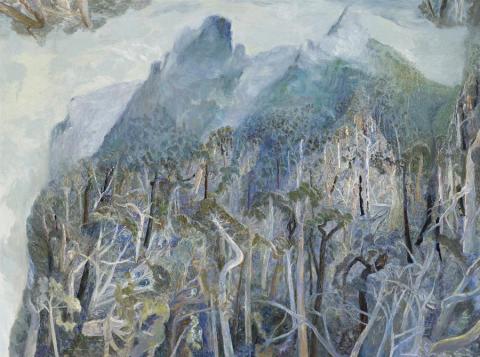NIMBIN ROCKS IN FOG, 1996
WILLIAM ROBINSON
oil on canvas
137.5 x 183.0 cm
signed and dated lower left: William Robinson 96
inscribed verso: NIMBIN ROCKS IN FOG
Ray Hughes Gallery, Sydney
Sam Neill Collection, New Zealand
Private collection, New South Wales
William Robinson, Ray Hughes Gallery, Sydney, 28 June – 24 July 1996, cat. 5 (illus. in exhibition catalogue)
William Robinson – A Retrospective, Queensland Art Gallery, Brisbane, 31 August – 11 November 2001; National Gallery of Australia, Canberra, 14 December 2001 – 10 March 2002
Seear, L., Darkness and Light: The Art of William Robinson, Queensland Art Gallery, Brisbane, 2001, p. 127 (illus.)
When leafing through numerous books on William Robinson it becomes clear that each period of the artist's development is punctuated by major shifts in palette and challenging innovations in composition.
From the early 1970s Bonnard-inspired scenes that depicted everyday family life in delicate pastel drawings, through to the whimsical and innovative Farmyards, we are drawn upwards into the tossed and twisted landscapes which have cemented the artist's reputation as an important landscape painter. Key to Robinson's innovation as an artist is his treatment of the horizon. The ceiling of the Sistine Chapel or Tiepolo's swirling skies come to mind as possible sources of inspiration, but there is also a connection to local artists as diverse as Ken Whisson and John Olsen, who both exhibit a commitment to the compositional possibilities of distorted space. Olsen's playful aerial views and often humorous narratives, Whisson's uncompromising analyses of colour, pictorial space and importantly multiple and varied horizon points, are each evident in William Robinson's work. Robinson exhibited at the same gallery and often alongside both of these artists during the 1970s and 1980s in an environment that encouraged the free exchange of ideas through artistic dialogue.
Also evident is Robinson's love of music. He is a virtuoso musician, and a baby grand piano shares his studio with the easels and works in progress. It is hardly a surprise when one looks at a Robinson that music plays such an important part in his work. The major compositions have a symphonic grandeur and delicate moods and tones work together to create timeless depictions of nature's architecture. In fact the manner with which he applies his paint could easily be compared with that of a composer, for the marks are often as tiny as a note of music, and vary little in size but work together to create the whole. In Nimbin Rocks in Fog, 1996 the mood is pensive, painted at a time when Robinson's spiritual faith had been tested1 it feels as though the artist is reflecting on his own innovations, the work is settled and close to conventional. Where the early works often featured Bill and Shirley Robinson experiencing an idyllic Adam and Eve like existence in their own Garden of Eden, these mature works are devoid of people, here the vision is biblical in both emotion and scale. As Robinson says,
'I consider the Mountain Series among my most important works ... I want to move away from observing the picture as some sort of representation. I want to sweep the observer down gullies and up into the sky. The observer is drawn into the landscape "not physically but as a sort of connection to memory. The painting reminds us of experiences we might have had when walking in the bush ... I am only presenting personal experience to be shared, but I would like to give some clues that may help the observer to experience the picture.'2
The fastidious attention to detail in Nimbin Rocks in Fog, 1996 shows the artist flaunting his expressive powers, and the overarching influences are all evident. Bonnard is there in the staccato colour application that fizzes on the surface, his love and understanding of music is there in virtuosity of the scale, and his religious conviction is deeply conveyed as ultimately these works are a profound homage to nature and creation.
1. Seear, L., Darkness and Light, The Art of William Robinson, Queensland Art Gallery, Brisbane, 2001, p. 23
2. Ibid., p. 118
HENRY MULHOLLAND
